Calibration Method of Measuring Heads for Testing Residual Stresses in Sheet Metal Using the Barkhausen Method
Abstract
1. Introduction
- Type I stresses (σ′—macro stresses), occurring throughout the continuum of the test object. They are caused by the macro-influence of a number of external factors, such as the variation in the internal structure caused by the machining and uneven cooling at different depths. These stresses mainly cause changes in workpiece dimensions and fractures.
- Type II stresses (σ″—micro stresses), occurring in the area of several adjacent grains and their boundaries, are caused by changes in the orientation of the grains with respect to each other and by the difference in specific volume between them.
- Type III stresses (σ‴—sub-micro stresses), affecting the region of several atomic distances and caused by numerous defects in the structure of the crystalline lattice after processing (vacancies, interstitial atoms, dislocations, lattice cracks, and delaminations).
2. Research Methods
2.1. Computer Simulations
2.2. Experimental Testing Methodology
3. Results of the Conducted Tests
4. Conclusions
Author Contributions
Funding
Institutional Review Board Statement
Informed Consent Statement
Data Availability Statement
Conflicts of Interest
References
- Guo, J.; Fu, H.; Pan, B.; Kang, R. Recent progress of residual stress measurement methods. A review. Chin. J. Aeronaut. 2021, 34, 54–78. [Google Scholar] [CrossRef]
- Guan, B.; Zang, Y.; Wu, D.; Qin, Q. Stress-inheriting behavior of H-beam during roller straightening process. J. Mater. Process. Technol. 2017, 244, 253–272. [Google Scholar] [CrossRef]
- Panton, S.M.; Zhu, S.D.; Duncan, J.L. Fundamental deformation types and sectional properties in roll forming. Int. J. Mech. Sci. 1994, 36, 725–735. [Google Scholar] [CrossRef]
- Gierczak, J.; Ignatowicz, L.R. Naprężenia własne w spawanych słupach skrzynkowych z kształtowników profilowanych na zimno. Builder 2020, 270, 19–23. [Google Scholar] [CrossRef]
- Moen, C.D.; Igusa, T.; Schafer, B.W. Prediction of residual stresses and strains in cold-formed steel members. Thin-Walled Struct. 2008, 46, 1274–1289. [Google Scholar] [CrossRef]
- Kula, E.; Weiss, V. (Eds.) Residual Stress and Stress Relaxation; Springer Science+Business Media: New York, NY, USA, 1982. [Google Scholar]
- Schleinzer, G.; Fischer, F. Residual stress formation during the roller straightening of railway rails. Int. J. Mech. Sci. 2001, 43, 2281–2295. [Google Scholar] [CrossRef]
- Hadjioannou, M.; Douthe, C.; Gantes, C. Influence of residual stresses inducted by cold curving on the resistance of I-section steel members. In Proceedings of the 6th European Conference on Steel and Composite Structures, EUROSTEEL 2011, Budapest, Hungary, 31 August–2 September 2011. [Google Scholar]
- Withers, P.J. Residual stress and its role in failure. Rep. Prog. Phys. 2007, 70, 2211–2264. [Google Scholar] [CrossRef]
- Milenin, A.; Kuziak, R.; Lech-Grega, M.; Chochorowski, A.; Witek, S.; Pietrzyk, M. Numerical modeling and experimental identification of residual stresses in hot-rolled strips. Arch. Civ. Mech. Eng. 2016, 16, 125–134. [Google Scholar] [CrossRef]
- Arasimowicz, A.; Piekarski, P. Pomiar naprężeń własnych metodą usuwania warstw w technologicznych warstwach wierzchnich. In Postępy Nauki i Techniki; Oddział SIMP, Lublin, Poland, 2011; pp. 5–13.
- Hidveghy, J.; Michel, J.; Bursak, M. Residual Stress in Microalloyed Steel Sheet. Metalurgija 2003, 42, 103–106. [Google Scholar]
- Garstka, T.; Koczurkiewicz, B.; Golański, G. Diagnostic examination of P265GH boiler steel plate using the Barkhausen method. Adv. Mater. Sci. 2010, 10, 81–92. [Google Scholar] [CrossRef]
- Ivanova, Y.; Partalin, T. Comparative measurements of the stress state in a rolled carbon steel using magnetic Barkhausen noise and ultrasonic method. Russ. J. Nondestruct. Test. 2012, 48, 137–146. [Google Scholar] [CrossRef]
- Radwański, K.; Adamiec, A.; Kuziak, R.; Zaława, D.; Sozańska-Jędrasik, L. Study on the influence of sheet straightening process on residual stress distribution, mechanical properties and structure of deep-drawing steel sheets. J. Met. Mater. 2021, 73, 3–10. [Google Scholar] [CrossRef]
- Withers, P.J.; Bhadeshia, H.K.D.H. Residual stress. Part 1—Measurement techniques. Mater. Sci. Technol. 2001, 17, 355–365. [Google Scholar] [CrossRef]
- Schajer, G.; Whitehead, P.S. Hole-Drilling Method for Measuring Residual Stresses; Morgan and Claypool Publishers: San Rafael, CA, USA, 2018. [Google Scholar]
- Marcinczak, K.; Lorenc, W.; Rowiński, S. Pomiar naprężeń własnych w kształtowniku stalowym metodą otworkową. Mater. Bud. 2018, 4, 103–104. [Google Scholar] [CrossRef]
- Hauk, M. Structural and Residual Stress Analysis by Nondestructive Methods; Elsevier: Amsterdam, The Netherlands, 1997. [Google Scholar]
- Tong, K.; Zhou, J.; Zhao, R.; Ying, H.; Zhang, S. Quantitative measurement of stress in steel bars under repetitive tensile load based on force-magnetic coupling effect. Measurement 2022, 202, 111820. [Google Scholar] [CrossRef]
- Sarmast, A.; Schubnell, J.; Preußner, J.; Hinterstein, M.; Carl, E. Residual stress analysis in industrial parts: A comprehensive comparison of XRD methods. J. Mater. Sci. 2023, 58, 16905–16929. [Google Scholar] [CrossRef]
- Tanaka, K. The cosα method for X-ray residual stress measurement using two-dimensional detector. Mech. Eng. Rev. 2019, 6, 18-00378. [Google Scholar] [CrossRef]
- Ivanova, Y.; Partalin, T. Investigation of stress-state in rolled sheets by ultrasonic techniques. Ultragarsas 2011, 66, 7–15. [Google Scholar] [CrossRef][Green Version]
- Żak, S.; Woźniak, D.; Cieślik, Ł. Wpływ zmian kalibrowania walców na stan naprężeń własnych w szynie kolejowej–eksperymenty przemysłowe. Hut. Wiadomości Hut. 2021, 88, 13–20. [Google Scholar] [CrossRef]
- Gauthier, J.; Krause, T.; Atherton, D. Measurement of residual stress in steel using, magnetic Barkhausen noise method. NDT&E Int. 1998, 31, 23–31. [Google Scholar]
- Ferreira da Silva, S.; Rodrigues Mansur, T.R.; Cruz, J.R.; Neto, M.M. The use of magnetic Barkhausen noise analysis for nondestructive determination of stresses in structural elements. In Proceedings of the International Nuclear Atlantic Conference, INAC2007, Santos, SP, Brazil, 30 September 2007. [Google Scholar]
- Le Manh, T.; Benitez, J.A.P.; Hernández, J.H.E.; López, J.M.H. Barkhausen Noise for Nondestructive Testing and Materials Characterization in Low-Carbon Steels; Woodhead Publishing: Sawston, UK, 2020. [Google Scholar] [CrossRef]
- Krause, T.W.; Pulfer, N.; Weyman, P.; Atherton, D.L. Magnetic Barkhausen noise: Stress-dependent mechanisms in steel. IEEE Trans. Magn. 1996, 32, 4764–4766. [Google Scholar] [CrossRef]
- Garstka, T.; Rydz, D. Explosively welded Ti-Ni bimetallic plate characterization using Barkhausen noise. J. Electr. Eng. 2015, 66, 186–189. [Google Scholar]
- Anglada-Rivera, J.; Padovese, L.R.; Capó-Sánchez, J. Magnetic Barkhau-sen Noise and hysteresis loop in commercial carbon steel: Influence of applied tensile stress and grain size. J. Magn. Magn. Mater. 2001, 231, 299–306. [Google Scholar] [CrossRef]
- Roskosz, M.; Fryczowski, K.; Schabowicz, K. Evaluation of Ferromagnetic Steel Hardness Based on an Analysis of the Barkhausen Noise Number of Events. Materials 2020, 13, 2059. [Google Scholar] [CrossRef] [PubMed]
- Holmberg, J.; Lundin, P.; Olavison, J.; Sevim, S. Non-destructive testing of surface characteristics after nitrocarburizing of three diferent steel grades. In Proceedings of the 12th International Conference on Barkhausen Noise and Micromagnetic Testing (ICBM12), Dresden, Germany, 25–26 September 2017. [Google Scholar]
- Accuracy in Residual Stress Measurement Methods. Met. Finish. News 2020, 21 March, pp. 18–21. Available online: https://www.mfn.li/archive/issue_view/2001/1 (accessed on 15 September 2024).
- Durin, G.; Zapperi, S. The Barkhausen effect. Sci. Hysteresis 2006, 2, 181–267. [Google Scholar]
- Jiles, D.C.; Kiarie, W. An integrated model of magnetic hysteresis the magnetomechanical effect and the Barkhausen effect. IEEE Trans. Magn. 2021, 57, 800211. [Google Scholar] [CrossRef]
- Garstka, T. Comparison of the Results of the Barkhausen Noise Investigations Conducted with Using Various Designs of Sensor. Przegląd Elektrotechniczny 2017, 7, 27–30. [Google Scholar] [CrossRef]
- Santa-aho, S.; Laitinen, A.; Sorsa, A.; Vippola, M. Barkhausen Noise Probes and Modelling. A Review. J. Nondestruct. Eval. 2019, 38, 94. [Google Scholar] [CrossRef]
- Garstka, T. The complex system for residua stress determination based on Barkhausen noise measurement. In Proceedings of the 5th International Conference on the Barkhausen Noise and Micromagnetic Testing, ICBM-5, Petten, The Netherlands, 2–3 June 2005. [Google Scholar]
- Grum, J.; Pecnik, B. Calibration of various sensor units by usingdifferent parameters of the magnetic Barkhausen noise. In Proceedings of the 4th International Conference on the Barkhausen Noise and Micromagnetic Testing, ICBM-4, Brescia, Itally, 3–4 June 2003. [Google Scholar]
- Augustyniak, B. Zjawiska Magnetosprężyste i ich Wykorzystanie w Nieniszczących Badaniach Materiałów; Politechnika Gdańska: Gdańsk, Poland, 2003. [Google Scholar]
- Lindgren, M.; Lepistö, T. Relation between residual stress and Barkhausen noise in a duplex steel. NDT & E Int. 2003, 36, 279–288. [Google Scholar] [CrossRef]
- Ferreira da Silva, S.; Rodrigues Mansur, R. Determining residual stresses in ferromagnetic materials by Barkhausen noise measurement. In Proceedings of the 15th World Conference on Non Destructive Testing, WCNDT, Roma, Itally, 15–21 October 2000. [Google Scholar]
- Vengrinovich, V.; Tsukerman, V.L. Stress and texture measurement using Barkhausen noise and angular scanning of driving magnetic field. In Proceedings of the 16th WCDNT—World Conference on Nondestructive Testing, Montreal, QC, Canada, 30 August–3 September 2004. [Google Scholar]
- Garstka, T. Barkhausen Noise Stress Characteristic of P265GH Boiler Steel. Acta Phys. Pol. A 2012, 121, 954–958. [Google Scholar] [CrossRef]
- Ducharne, B.; Tene Deffo, Y.A.; Tsafack, P.; Nguedjang Kouakeuo, S.H. Directional magnetic Barkhausen noise measurement using the magnetic needle probe method. J. Magn. Magn. Mater. 2021, 519, 167453. [Google Scholar] [CrossRef]
- Tonshoff, H.; Friemuth, T.; Obereck, I.; Seegers, H. Micromagnetic stress determination on tailored blanks. In Proceedings of the 15th WCNDT, World Conference on Nondestructive Testing, Roma, Italy, 15–21 October 2000. [Google Scholar]
- Vengrinovich, V.; Tsukerman, V.; Denkevich, Y.; Bryantsev, D. New Parameters to Characterize Internal Stresses via Barkhausen Noise. In Proceedings of the 9th European Conference on Nondestructive Testing, Berlin, Germany, 25–29 September 2006; pp. 1–7. [Google Scholar]
- Norton, F.H. Creep of Steel at High Temperature; McGraw Hill, New York, NY, USA, 1929.
- Hoff, N.J. Approximate Analysis of Structures in the Presence of Moderately Large Steps Deformation. Quart. Appl. Mech. 1954, 2, 49. [Google Scholar]
- Hensel, A.; Spittel, T. Kraft und Arbeitsbedarf Bildsomer Formgeburgs; VEB Deutscher Verlang für Grundstoffindustrie, Lipsk, Germany, 1979.
- PN-EN ISO 6892-1:2016-09; Metale—Próba Rozciągania—Część 1: Metoda Badania w Temperaturze Pokojowej. ISO: Geneva, Switzerland, 2016. (In Polish)
- Available online: http://mag-lab.pl/stronka/meb-2c.htm (accessed on 15 September 2024).
- Xia, Y.; Li, Z.; Schafer, B.W.; Blum, H. Experimental study on residual stresses of dual phase high-strength cold-formed steel angles. ce/papers 2021, 4, 387–392. [Google Scholar] [CrossRef]
- Levenberg, K. A method for the solution of certain nonlinear problems in least squares. Quart. Appl. Math. 1944, 2, 164–168. [Google Scholar] [CrossRef]
- Marquardt, D.W. An algorithm for least squares estimation of nonlinear parameters. J. SIAM 1963, 11, 431–441. [Google Scholar] [CrossRef]
- Marquardt, D.W. Generalized inverses, ridge regression, biased linear estimation and nonlinear estimation. Technometrics 1970, 12, 591–612. [Google Scholar] [CrossRef]
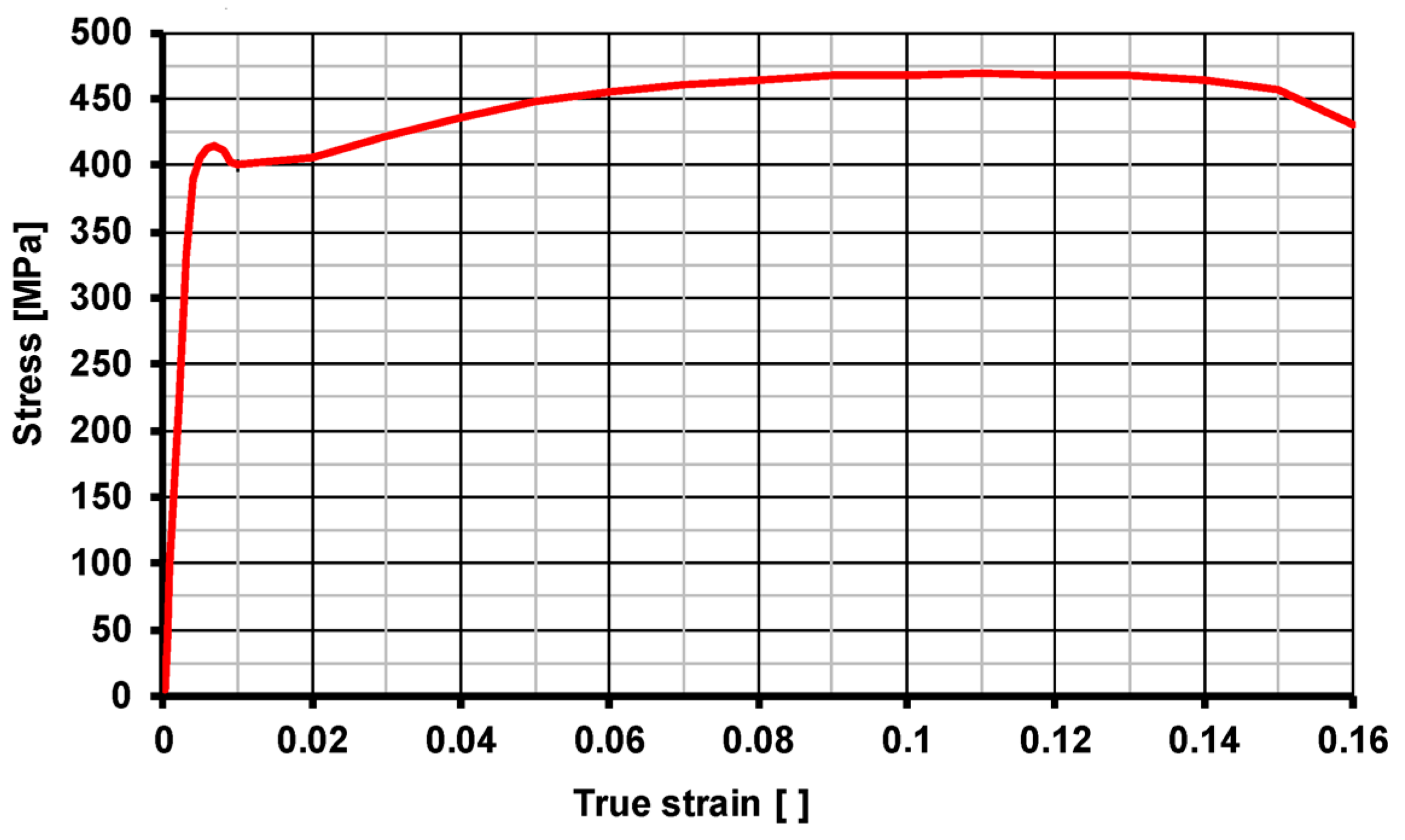
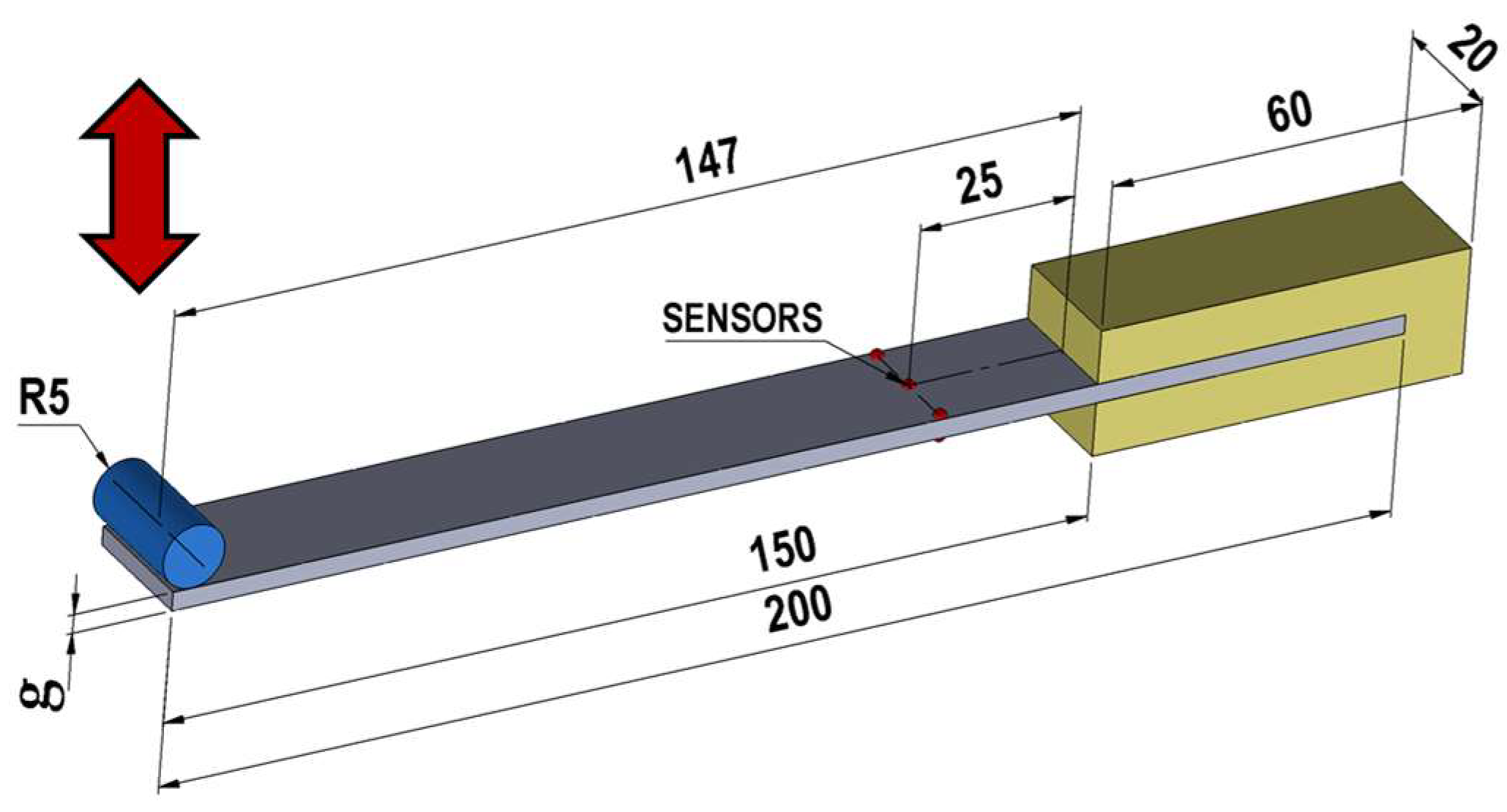
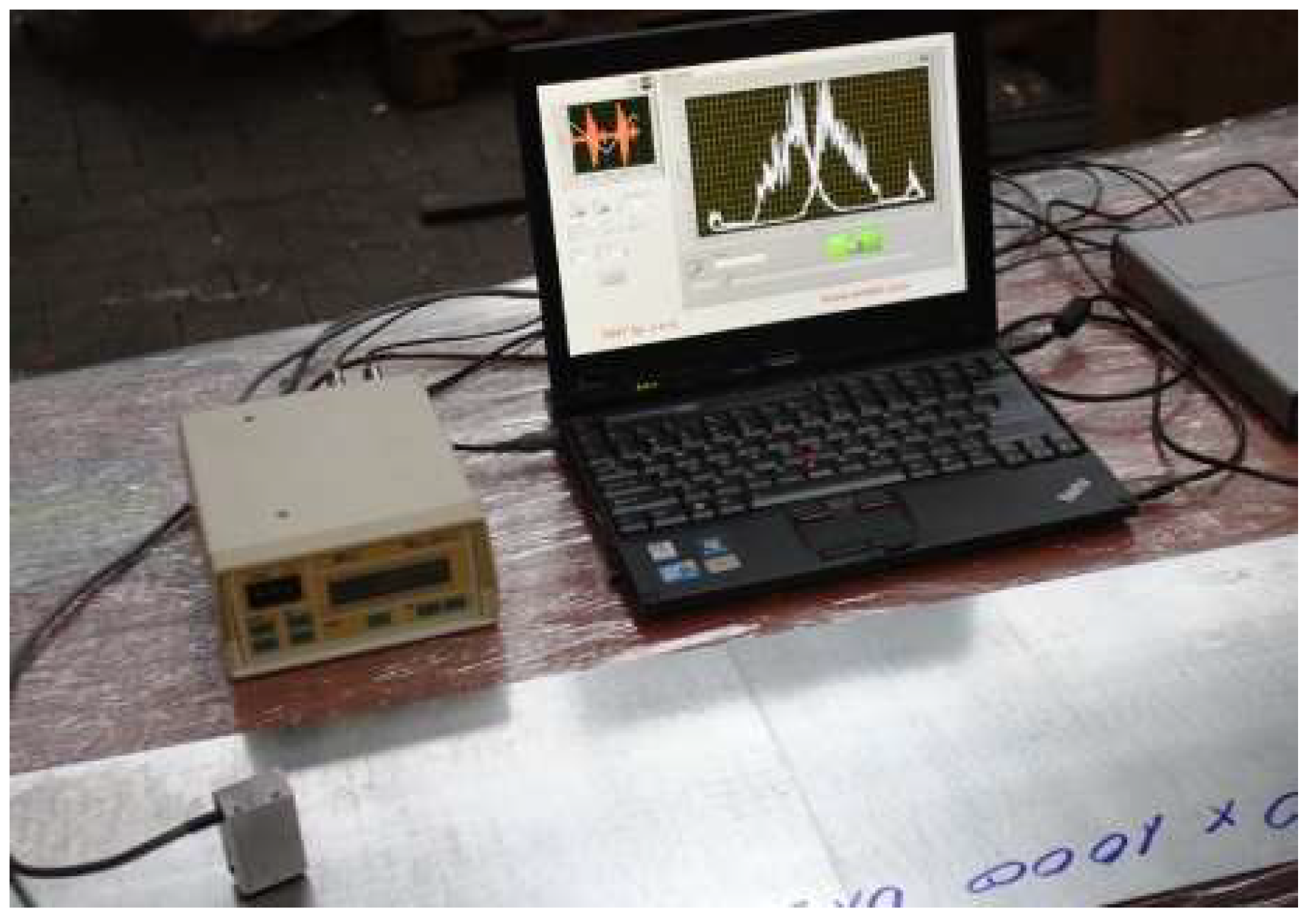

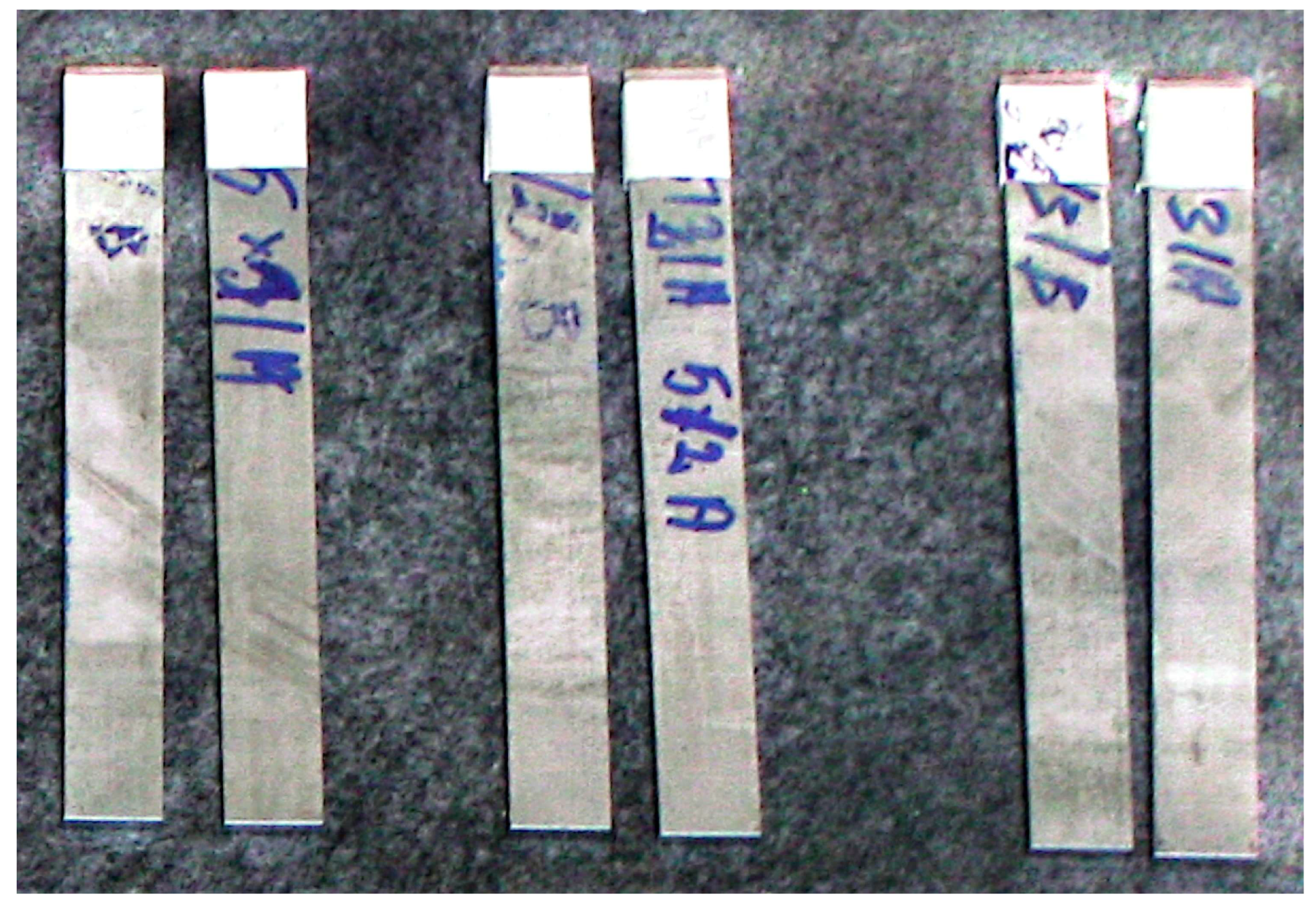
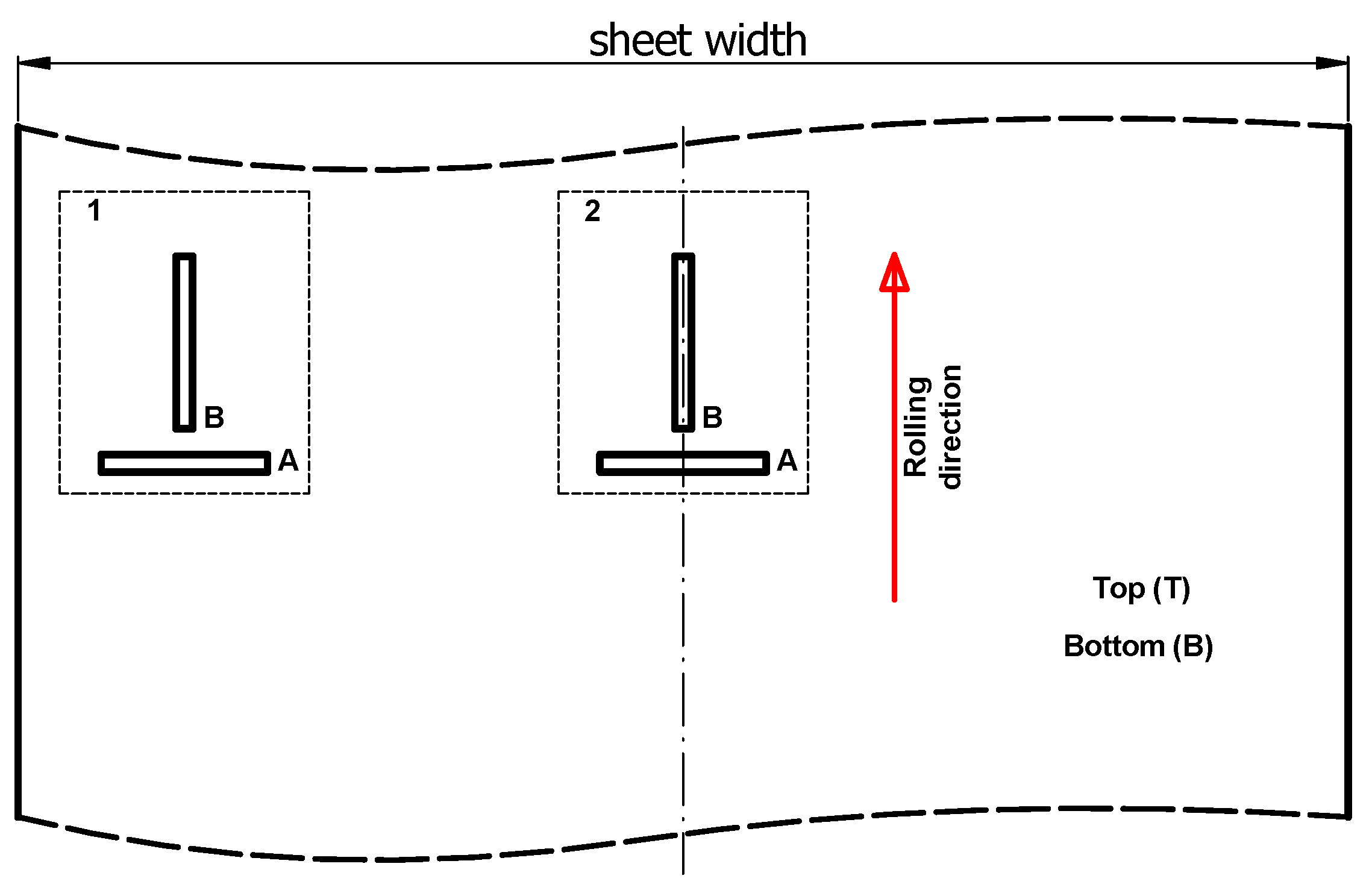
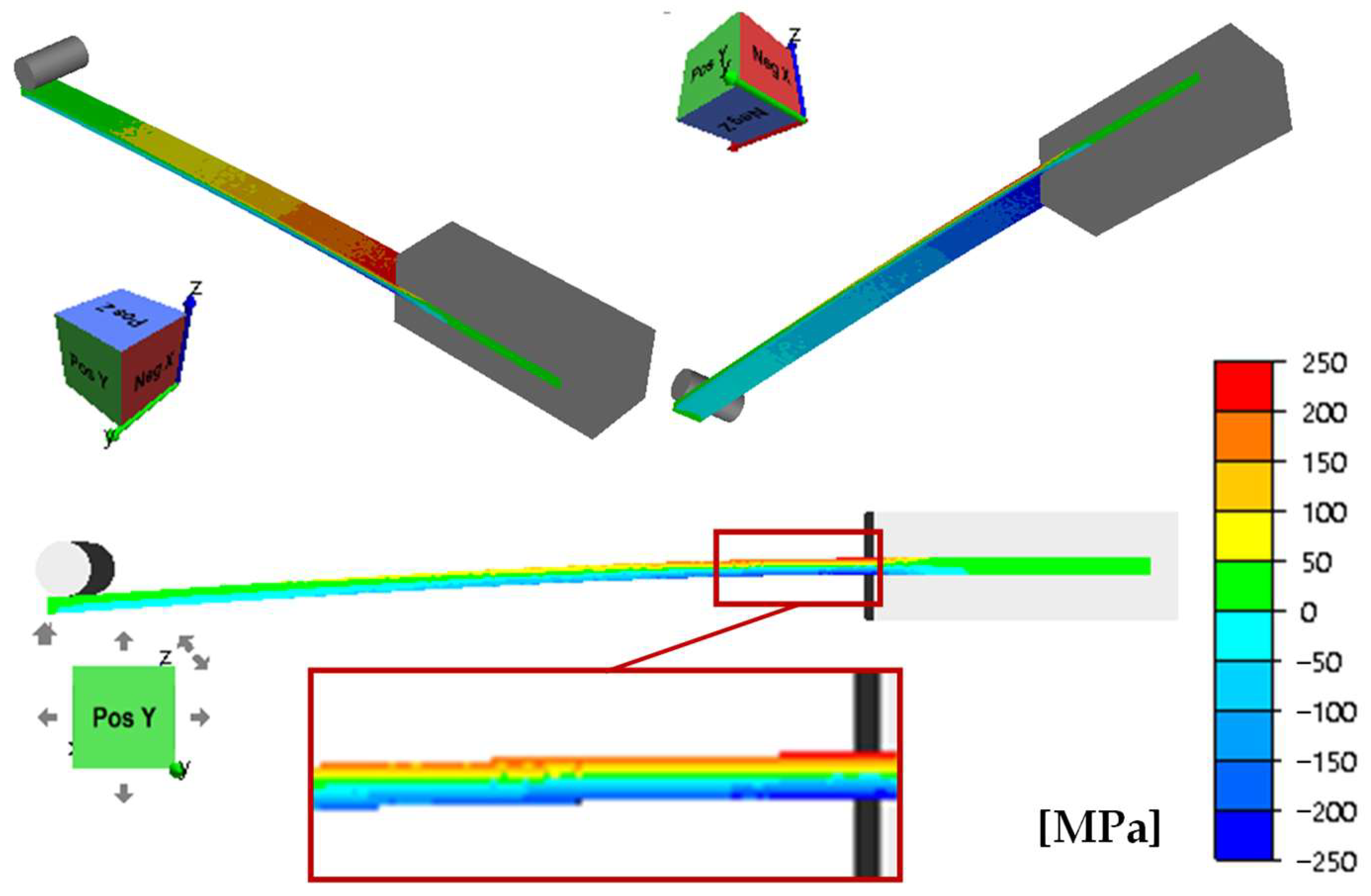
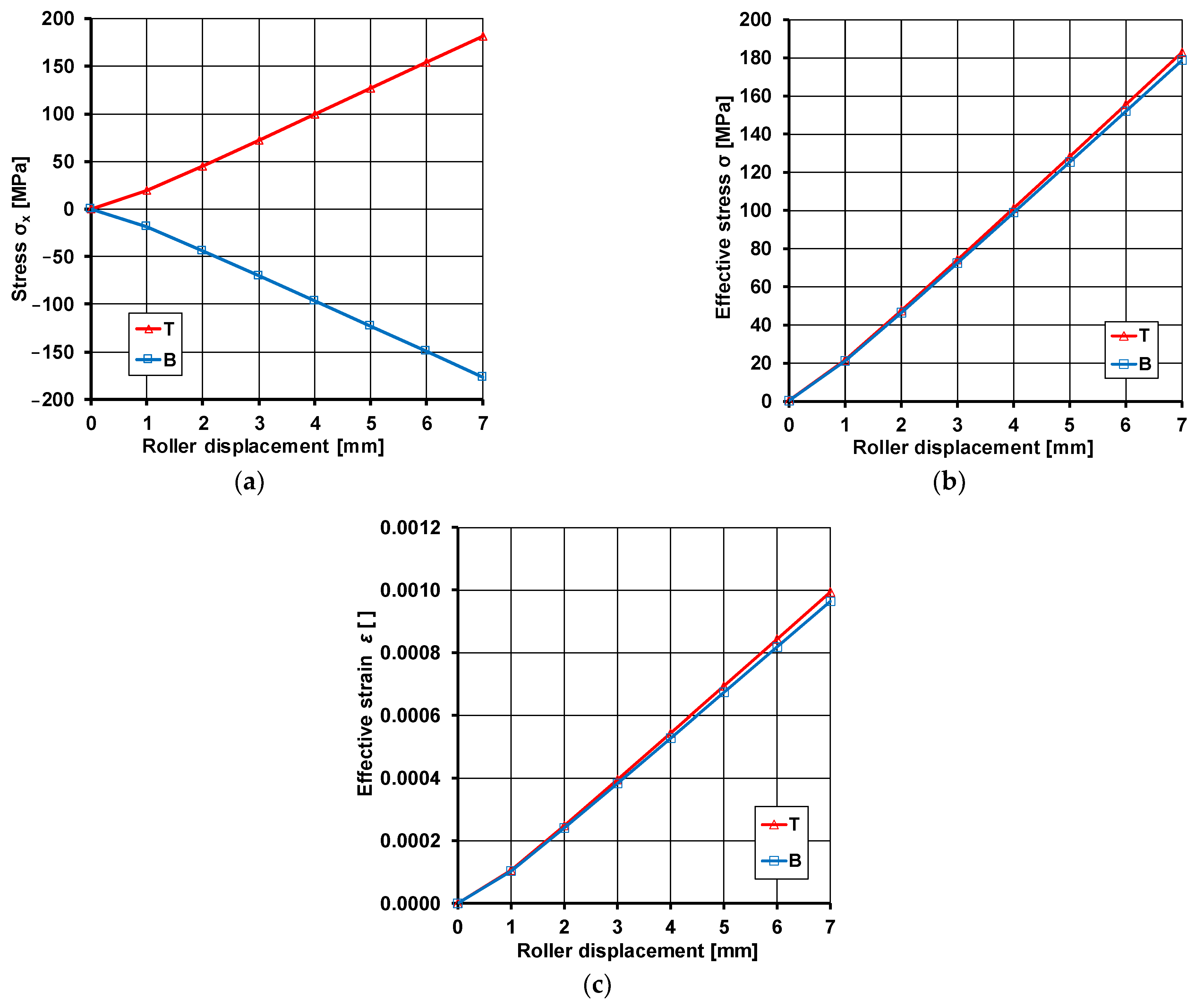
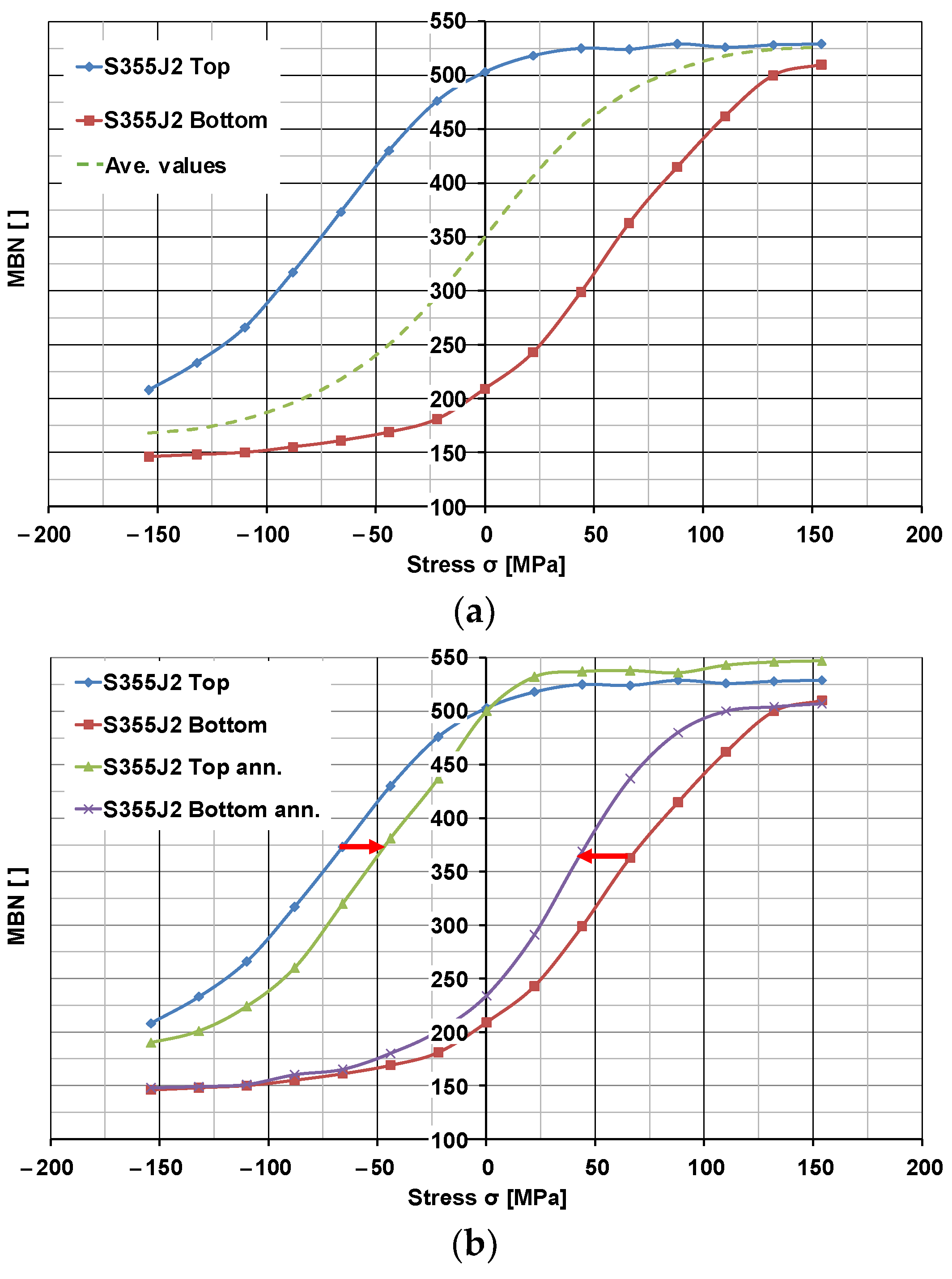

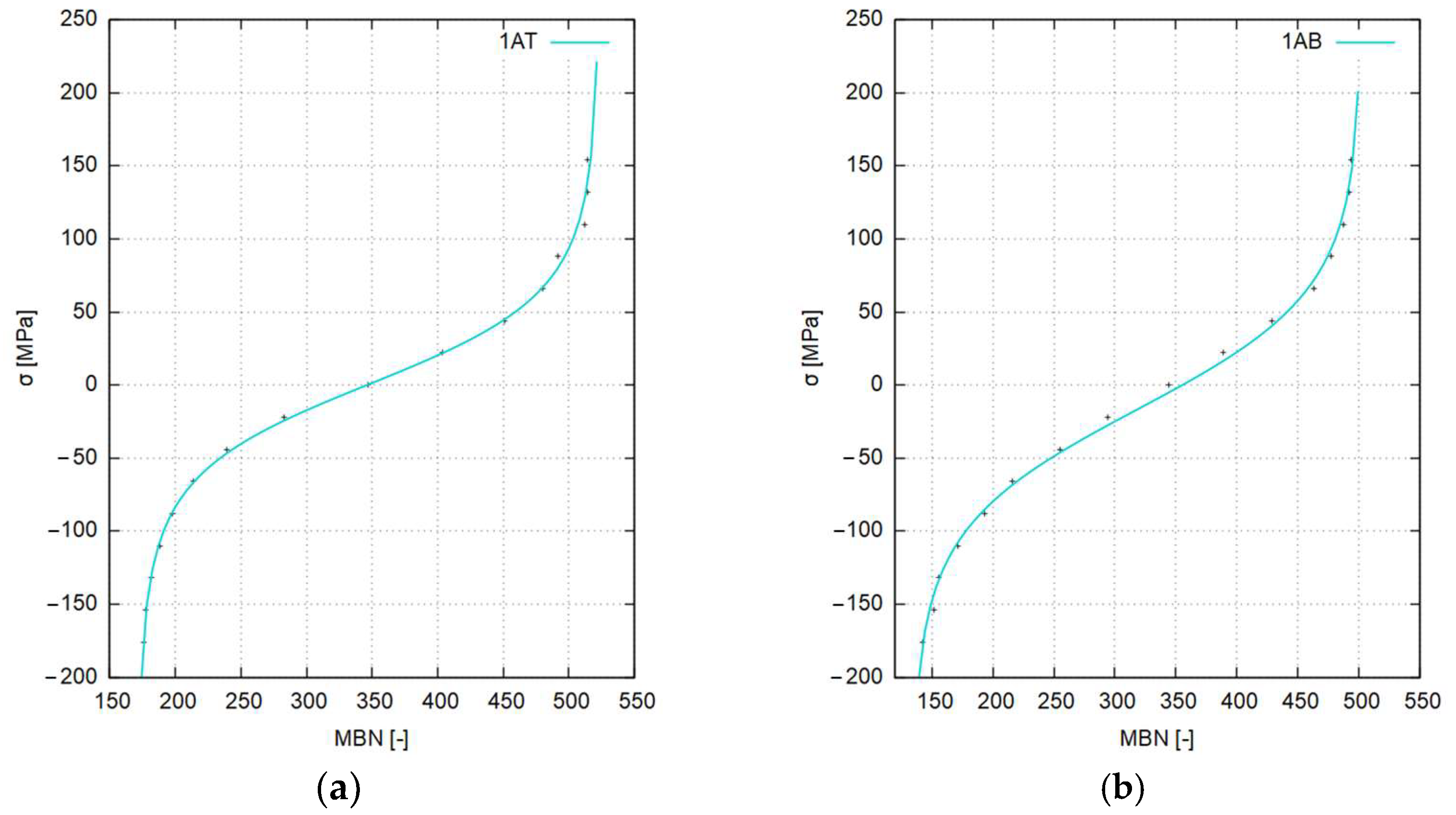
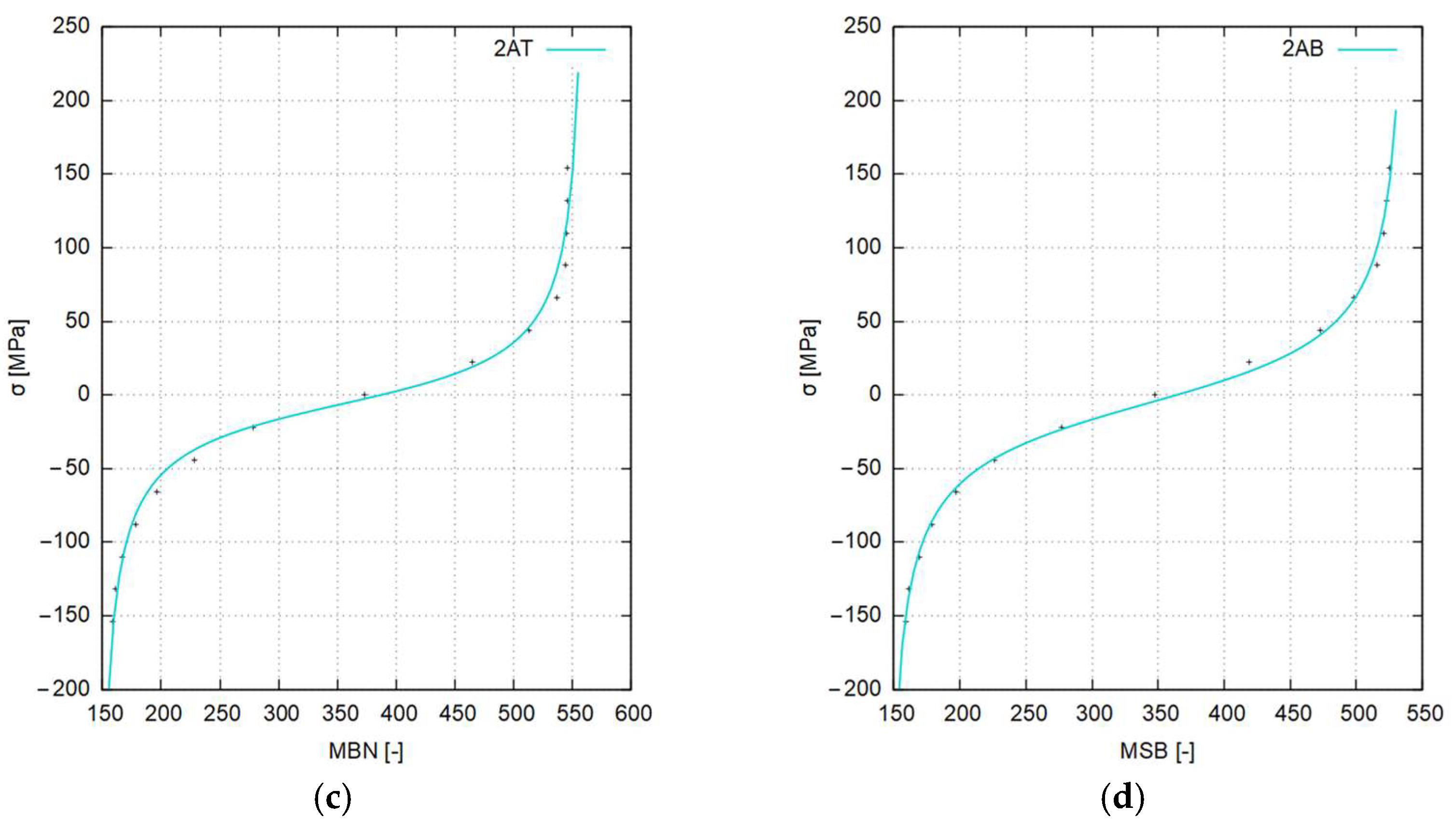
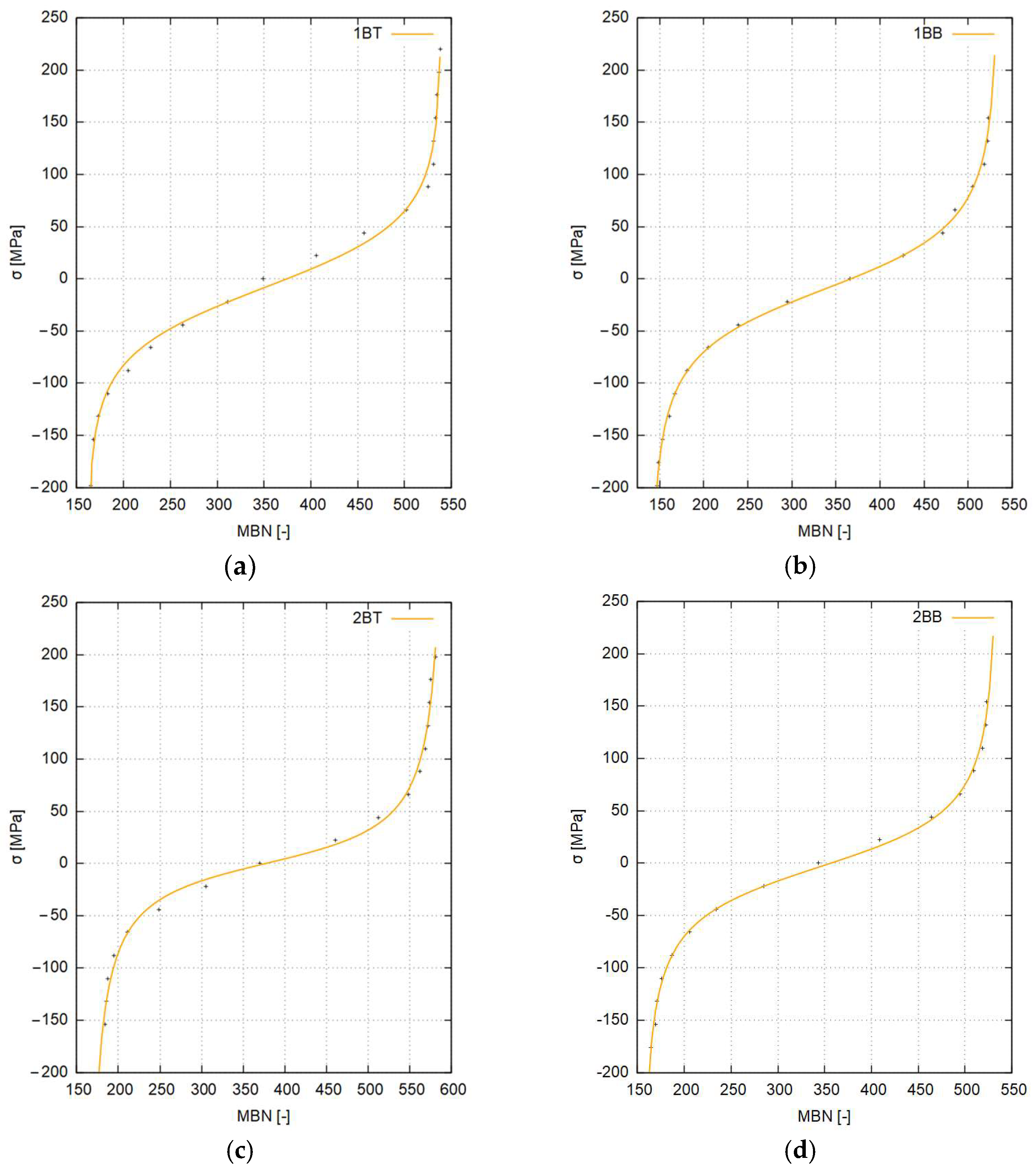
| C | Mn | Si | P | S | Cr | Mo | V | Nb | Ti | Al | Cu | |
|---|---|---|---|---|---|---|---|---|---|---|---|---|
| PN-EN S355J2 | 0.20 | 1.60 | 0.55 | Max 0.025 | Max 0.025 | - | - | - | - | - | - | Max 0.55 |
| Tested S355J2 | 1.185 | 1.5 | 0.3 | 0.005 | 0.005 | - | - | - | - | - | 0.003 | 0.1 |
| Steel Grade | Yield Strength YS [MPa] | Strength Limit UTS [MPa] | Young’s Modulus E [GPa] | Max. Absolute Error Δ [MPa] | Max. Relative Error δ [%] |
|---|---|---|---|---|---|
| S355J2 | 410 | 468 | 181 | ±4.28 | 0.91 |
| Steel | Measured Parameter | Roller Displacement Value [mm] | ||||||
|---|---|---|---|---|---|---|---|---|
| 1 | 2 | 3 | 4 | 5 | 6 | 7 | ||
| S355J2 | Effective stress σ [MPa] | 21.2 | 46.5 | 72.4 | 98.9 | 125.4 | 152.1 | 178.8 |
| Effective strain ε [ - ] | 0.000104 | 0.000245 | 0.000389 | 0.000536 | 0.000683 | 0.000830 | 0.000979 | |
| Sample Deflection, [mm] | S355J2 in the As-Delivered Condition | |||||||
|---|---|---|---|---|---|---|---|---|
| Edge of Sheet 1 | Center of Sheet 2 | |||||||
| Transverse A | Longitudinal B | Transverse A | Longitudinal B | |||||
| Top | Bottom | Top | Bottom | Top | Bottom | Top | Bottom | |
| −7 | 178 | 140 | 208 | 146 | 165 | 155 | 179 | 164 |
| −6 | 179 | 142 | 233 | 148 | 167 | 157 | 185 | 166 |
| −5 | 181 | 144 | 266 | 150 | 173 | 163 | 197 | 167 |
| −4 | 185 | 149 | 317 | 155 | 183 | 173 | 219 | 169 |
| −3 | 193 | 167 | 373 | 161 | 199 | 189 | 259 | 177 |
| −2 | 203 | 195 | 430 | 169 | 231 | 216 | 329 | 197 |
| −1 | 220 | 226 | 476 | 181 | 275 | 260 | 413 | 225 |
| 0 | 251 | 272 | 503 | 209 | 368 | 333 | 483 | 283 |
| 1 | 300 | 313 | 518 | 243 | 450 | 404 | 533 | 345 |
| 2 | 360 | 365 | 525 | 299 | 497 | 456 | 553 | 413 |
| 3 | 412 | 408 | 524 | 363 | 518 | 481 | 566 | 466 |
| 4 | 450 | 441 | 529 | 415 | 526 | 501 | 567 | 488 |
| 5 | 471 | 466 | 526 | 462 | 526 | 509 | 568 | 502 |
| 6 | 476 | 471 | 528 | 469 | 526 | 512 | 569 | 506 |
| 7 | 478 | 473 | 529 | 471 | 526 | 514 | 570 | 508 |
| Sample Deflection, [mm] | S355J2 in Annealed Condition | |||||||
|---|---|---|---|---|---|---|---|---|
| Edge of Sheet 1 | Center of Sheet 2 | |||||||
| Transverse A | Longitudinal B | Transverse A | Longitudinal B | |||||
| Top | Bottom | Top | Bottom | Top | Bottom | Top | Bottom | |
| −7 | 173 | 160 | 201 | 148 | 153 | 162 | 189 | 172 |
| −6 | 173 | 163 | 224 | 149 | 155 | 165 | 192 | 175 |
| −5 | 179 | 175 | 260 | 151 | 161 | 175 | 203 | 183 |
| −4 | 183 | 191 | 315 | 160 | 173 | 185 | 239 | 197 |
| −3 | 192 | 205 | 325 | 165 | 193 | 205 | 281 | 215 |
| −2 | 207 | 237 | 381 | 180 | 225 | 235 | 327 | 243 |
| −1 | 227 | 275 | 437 | 201 | 281 | 293 | 438 | 287 |
| 0 | 266 | 322 | 500 | 234 | 377 | 363 | 491 | 341 |
| 1 | 333 | 369 | 532 | 291 | 479 | 433 | 542 | 404 |
| 2 | 396 | 417 | 537 | 369 | 528 | 490 | 557 | 462 |
| 3 | 452 | 460 | 538 | 437 | 555 | 514 | 570 | 501 |
| 4 | 489 | 482 | 536 | 480 | 561 | 530 | 575 | 516 |
| 5 | 508 | 507 | 543 | 500 | 563 | 532 | 578 | 532 |
| 6 | 512 | 512 | 546 | 504 | 565 | 533 | 580 | 536 |
| 7 | 514 | 514 | 547 | 507 | 566 | 535 | 581 | 538 |
| Steel Grade | a0 | a1 | a2 | a3 | R2 | δ% δ%YE [%] |
|---|---|---|---|---|---|---|
| S355J2 | −2.88626 | −347.141 | 0.0163897 | 15.4037 | 0.9966 | 9.7 1.5 |
| No. | Sample * | a0 | a1 | a2 | a3 | a4 | R2 | δ% [%] |
|---|---|---|---|---|---|---|---|---|
| 1 | 1BT | 148.733 | 0.442600 | 0.00529000 | −350.60 | −8.4100 | 0.9964 | 10.1 |
| 2 | 1BB | 78.716 | 0.828892 | 0.00504245 | −337.17 | −9.88456 | 0.9991 | 4.2 |
| 3 | 2BT | 25.312 | 1.652280 | 0.00461565 | −378.52 | 0.1846 | 0.9959 | 10.6 |
| 4 | 2BB | 55.340 | 1.014560 | 0.00524665 | −345.48 | −3.4401 | 0.9986 | 5.0 |
| 5 | 1AT | 109.001 | 0.589351 | 0.00566458 | −347.285 | 0.38637 | 0,9977 | 4,9 |
| 6 | 1AB | 339.924 | 0.240834 | 0.00544643 | −318.057 | −16.8533 | 0.9986 | 7.3 |
| 7 | 2AT | 26.870 | 1.410490 | 0.00480442 | −354.319 | −6.11260 | 0.9910 | 11.0 |
| 8 | 2AB | 43.287 | 1.160367 | 0.00508767 | −341.671 | −5.80557 | 0.9980 | 6.7 |
Disclaimer/Publisher’s Note: The statements, opinions and data contained in all publications are solely those of the individual author(s) and contributor(s) and not of MDPI and/or the editor(s). MDPI and/or the editor(s) disclaim responsibility for any injury to people or property resulting from any ideas, methods, instructions or products referred to in the content. |
© 2024 by the authors. Licensee MDPI, Basel, Switzerland. This article is an open access article distributed under the terms and conditions of the Creative Commons Attribution (CC BY) license (https://creativecommons.org/licenses/by/4.0/).
Share and Cite
Garstka, T.; Szota, P.; Mróz, S.; Stradomski, G.; Gróbarczyk, J.; Gryczkowski, R. Calibration Method of Measuring Heads for Testing Residual Stresses in Sheet Metal Using the Barkhausen Method. Materials 2024, 17, 4584. https://doi.org/10.3390/ma17184584
Garstka T, Szota P, Mróz S, Stradomski G, Gróbarczyk J, Gryczkowski R. Calibration Method of Measuring Heads for Testing Residual Stresses in Sheet Metal Using the Barkhausen Method. Materials. 2024; 17(18):4584. https://doi.org/10.3390/ma17184584
Chicago/Turabian StyleGarstka, Tomasz, Piotr Szota, Sebastian Mróz, Grzegorz Stradomski, Jakub Gróbarczyk, and Radosław Gryczkowski. 2024. "Calibration Method of Measuring Heads for Testing Residual Stresses in Sheet Metal Using the Barkhausen Method" Materials 17, no. 18: 4584. https://doi.org/10.3390/ma17184584
APA StyleGarstka, T., Szota, P., Mróz, S., Stradomski, G., Gróbarczyk, J., & Gryczkowski, R. (2024). Calibration Method of Measuring Heads for Testing Residual Stresses in Sheet Metal Using the Barkhausen Method. Materials, 17(18), 4584. https://doi.org/10.3390/ma17184584







